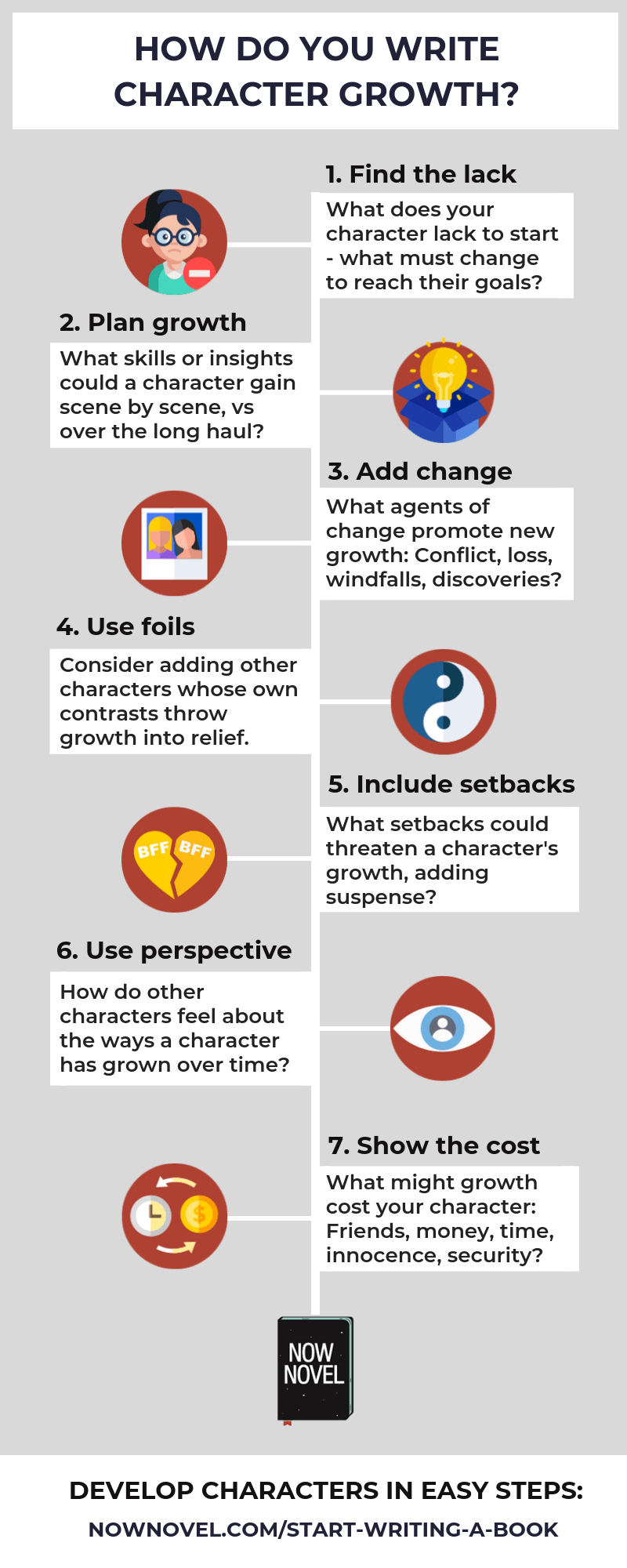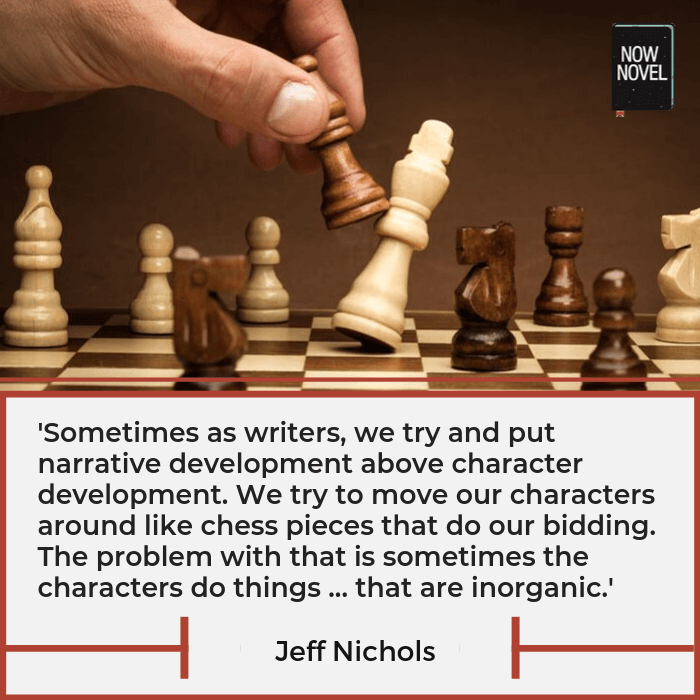Growth and change are elements that make characters’ paths interesting. How do you write character growth into your story? Read seven approaches:
How to write character growth: 7 stages
- Find what characters lack to begin
- Plan short-term and long-range growth
- Weave in agents of change
- Highlight character growth using foils
- Include interesting setbacks
- Use other characters for varied perceptions
- Show the cost of growth
1. Find what characters lack to begin
Fiction is full of characters who are introduced in a novice state, or with some or other lack. In fantasy, for example, we often find the magic student or apprentice who has not yet discovered the extent or cost of their powers.
In realist, contemporary or classic fiction, missing powers and attributes may be personal rather than magical. Perhaps a character lacks an important quality key to their goals, such as:
- Courage
- Self-belief/confidence
- Trust
- Determination
- Empathy
- Knowledge
Giving characters lacks can also bestow related strengths.
In Arthurian legend, the knight Percival’s innocence (due to being raised isolated in the woods) also gives him a disarming, innocuous quality. This aids him in winning others’ confidence and trust. Thus what a character needs to ‘grow out of’ may also be a quality that will stand them in good stead, depending on the situations that arise in their journey.
2. Plan short-term and long-range growth
What can your character learn, change or achieve in a single chapter? And over the story as a whole?
Thinking about a character’s ultimate goal along with the individual steps it will take them to achieve it will help you create scenes that together show a course of growth.
For example, the ‘reluctant hero’ type who is assigned a terrifying task may overcome a smaller conflict (or series of conflicts) first, trial runs for the ultimate confrontation. This is a common approach in series in which a character must dispatch an arch villain in the end, but face off against their powerful cronies in the first books’ core conflicts.
Once you know what your character’s ultimate goal is – getting Olympic gold, dating a crush, getting their doctorate, defeating a tyrannical ruler – think out incidents that show them acquiring the tools they’ll need.
3. Weave in agents of change
In order for there to be growth or change, there needs to be an agent of change. A catalyst. For example, a girl upset enough about environmental destruction to take a public stand and get media outlets and policy-makers talking.
We could have said ‘conflict’ instead of ‘agents of change’. But Ursula K. Le Guin reminds us that ‘conflict’ isn’t the only driving force behind people’s decisions and actions:
Modernist manuals of writing often conflate story with conflict. This reductionism reflects a culture that inflates aggression and competition while cultivating ignorance of other behavioral options. No narrative of any complexity can be built on or reduced to a single element. Conflict is one kind of behavior. There are others, equally important in any human life, such as relating, finding, losing, bearing, discovering, parting, changing.
Change is the universal aspect of all these sources of story. Story is something moving, something happening, something or somebody changing.
Ursula K. Le Guin, in Steering the Craft: A Twenty-first-century Guide to Sailing the Sea of Story, p. 123
As you write, think about how any of these agents of change – finding, losing, parting and others – cause characters to grow or develop.
In many novels, for example, the end of a relationship due to death or another separation causes a character to reassess their lives, make new choices or depart on new adventures.
[Finishing a book is easier with a structured plan and process – try the Now Novel dashboard and get feedback in our writing groups.]
4. Highlight character growth using foils
How do you write character growth in a multi-character story?
One of the advantages of a larger cast of main and supporting characters is you can give your characters ‘foils’.
A ‘foil’ in fiction as Cambridge Dictionary defines it is ‘something or someone that makes another’s good or bad qualities more noticeable’. For example, the ‘virtuous’ character in a story may appear alongside a low, vulgar person. Each character bring’s their foil’s habits into stark contrast.
Including a character who is opposite in key ways to a main character is a great way to force a character to engage with a lack or challenge. For example, a dour, surly person may have a friend who’s an endless optimist. The friend’s qualities may teach the first over time how to be more stoic, or other qualities (try-again optimism) that could prove essential to them.

Create mains, foils and more
Create character profiles with summaries, avatars and more and brainstorm your book.
DEVELOP YOUR IDEA5. Include interesting setbacks
There are bound to be setbacks in any growth process. The talented lead in a pressured director’s play arrives drunk to rehearsal. The promising artist has all their materials stolen 3 weeks before an exhibition’s opening night.
Giving characters setbacks supplies narrative tension while also making the passage from novice to pro interesting, believable and varied.
Take, for example, the growth of a romantic lead in a story. Say their greatest challenges relate to trust. What could happen in the course of a growing relationship to cause their trust to waiver?
List possible setbacks to your character’s growth in a bullet list, for example, for the above character:
- The would-be lover goes MIA with no explanation
- They glance over at the other’s phone and spy a suspicious looking notification
- They overhear a puzzling, anxiety-inducing snatch of a phone call
- The other’s ex comes back into their life for some unknown reason
Keeping a character’s growth uncertain adds suspense and intrigue, as your reader wants to know if your character will overcome their ‘shadow’ or not. Finish story arcs with a sense that the path behind was rocky, the way well-earned.

6. Use other characters for varied perceptions
An effective way to reveal a character’s growth is to show it from another character’s point of view.
An example we often return to is the relationship between Elizabeth Bennett and Mr Darcy in Austen’s Pride and Prejudice. Lizzie is initially wounded when she overhears Mr Darcy describing her as plain at a dance. Yet through the integrity of Mr Darcy’s actions moving on from this event (such as his protecting Lizzie’s sister’s honour), Lizzie gains respect for him.
Darcy’s growth in the story is filtered through Lizzie’s perspective, so that contradicting ideas of who he is – the aloof, antisocial man at a dance versus the caring, upstanding person – shift and evolve.
If a character who is a notorious bully suddenly starts acting meek, how does this look and feel to the kid they slam into the school lockers every day? Versus their usual cronies? What may look like evolving growth to some may look like devolving or ‘chickening out’ to others.
7. Show the cost of growth
Although politicians and others love to promise miraculous, endless growth, growth usually comes at a cost.
Whether we’re talking about economic growth or character growth, the same principle applies. What are the ingredients of it? Who wins and who loses out in the process? Who resents whom? Character growth can be fascinating, since as one character learns more, improves more, changes, another could grow envious or anxious as a result.
We see this effect often in fiction in the character type of ‘rival’. What does your character overcoming inner and external conflicts (and handling other ‘agents of change’) cost them? They may have to travel far from home. Cut off relationships holding them back, or make other key life changes.
Ready to plan your book? Create character profiles and a useful story outline online now.



4 replies on “How do you write character growth? 7 tips”
Great stuff as usual. Character is where I thrive and I feel I usually do well with. But I’m trying my hand at a romantic comedy in which she doesn’t really “grow” until the end. Rather, she piles on the mistakes until it all comes down. Does it count as good character growth, if the character only realizes her issues/mistakes at the last minute?
Thanks, 2Cents, thank you for reading our blog.
I’d say ‘self-awareness’ is a believable character trait to develop as a focal point as many people make mistakes in intimate relationships due to a lack of this. It can also be quite endearing (for example, in the bumbling Bridget Jones -type character type). Good luck with your romantic comedy!
As usual, I’m late to the party. And so glad this article stuck around! Your topic actually showed me exactly where my heart is trying to take me. A series of supporting characters who make it possible to have conversations that help the protagonist get a truer aim toward his goals. Thank you.
Thank you so much for your kind words! I’m really glad the article resonated with you and helped bring clarity to your story direction. Supporting characters can be such a powerful tool to guide a protagonist’s journey.